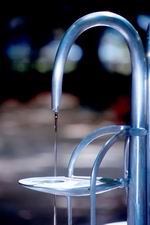 |
Fiuggi: travel guide |
The water. Around the water the Spa. Around the Spa greenery. And around everything, over everything, the sense of calm and well-being so hard to find nowadays. That's how Fiuggi is another world, an island of peace where you can immerse yourself and restore you mind even before your body. |
| Related images (8) |
|
The water that breaks stones It all started with the water. A small spring which attracted the attention of famous people as early as the Middle Ages. Pope Boniface VIII, for example, who was born in Ciociaria and knew the source well. Account books conserved in the Vatican record as many as 187 payment orders for the transport of water from “Anticoli in Capagna”, as the town of Fiuggi was called at that time. And praise of the water “that breaks stones” also appears in letters written by Michelangelo around 1549. What made this water indispensable for Kings, nobles and ambassadors was its miraculous ability unchanged today, even though the miracle is really a natural wonder. In fact Fiuggi stands on a tufaceous formation which alternates permeable and semi-permeable layers through the water filters and is purified, thus acquiring its beneficial properties. It is only in Fiuggi that this very special water with a low combines diuretic properties with the ability to “dissolve” and expel kidney stones.
Discovering the town
The origins of Fiuggi go back to before Roman times when the little village of Felcia shared the fate of the Hernican confederation which, after continuous clashes and alliances, was finally conquered by Rome in 367 BC. There is little reliable information about the Roman period: it is Known that Felcia was on the Via Prenestina and that the properties of its waters were already known under the name of “Fons Arilla”. However, it was in the Middle Age that the town developed and acquired greater importance with the name of Anticoli di Campagna, which it kept until the beginning of last century. The affairs of the little town were always linked with those of the Papal State to which it belonged as a fief of the main Roman families. The castle of Anticoli, which has now totally disappeared, changed hands between the Cajetani, Sforza and Borgia families and, lstly, went to the Colonnas who kepttheir hold in the town until 1816 when they relinquished the fief because of the heavy taxes imposed by Pope Pius VII. The town remained part of the Papal State until the unification of Italy, except for a brief period under Napoleonic government. Testimony to the long history of Anticoli di Campagna can still be seen in the perfectly preserved, magnificent mediaeval town. It is the oldest part of Fiuggi, surrounded by the wall, bastions and gates of the old town perched at an altitude of 747 metres. The town later spread out, lower down in the valley, when it really started to development. This all happened very quickly: in 1911 the humbled Anticoli di Campagna became Fiuggi and this date is the watershed between the old pastoral village and the modern tourist resort. The name Fiuggi probably comes from the ferns - “fiugy” in dialect – that grew in the surrounding woods, or according to some theories, from the Italian word “fugge” which meaning “flees” because the water escapes so quickly from the body. The magnificent Grand Hotel Città di Fiuggi was also built in 1910 and the most important italian shows of the period were staged in its theatre during the summer. Fonte Bonifacio VIII was inaugurated in 1911 and in 1913 the Grande Albergo Palazzo della Fonte was opened one of the honour of a visit from the royal family the following year. The leading lights of politics, art, aristocracy, and finance always spent a few days at the Fiuggi Spa. Those booming years were brought to an abrupt end by the Second World War during which many areas of Ciociara, including Montecassino were heavily bombed. Today Fiuggi is one of the most important spas in Europe. Next to Rome, it is the best equipped town in Latium as far as tourist hotel facilities are concerned. But the town's atmosphere bears no resemblance to an over-crowded holiday resort. Fiuggi is still a little mediaeval town in the heart if Ciociara, a land with ancient rural traditions that has succeeding in Keeping alive its rhythms, its culture and its nature.
Texts and photos courtesy of A.P.T. Frosinone
| |
 |
Search other Guides |
Related arguments
| Ciociaria: art and abbeys |
| Fiuggi Spas |
| Fiuggi's treasures |
| Fiuggi: its gastronomy |
| Nature |
| Sport in Fiuggi |
| Traditions and folklore in Fiuggi |

 Munch: The Scream Within
Munch: The Scream WithinOne of the year’s most eagerly awaited exhibitions to open its doors on 14 September 2024: Edvard Munch is back in Milan with a major retrospective after a 40-year absence.
 In the garden
In the gardenThe initiative, which is scheduled to run from June 26th to September 13th, 2020, is inaugurating a temporary space for art in Corso Matteotti 5, in Milan, in the very heart of the city.
 Perugia Travel Guide
Perugia Travel GuidePerugia is the chief town of Umbria. This beautiful town is sited on a hill in the middle of a verdant country. His central square is considered one of the most beautiful squares of Italy and history, traditions, art and nature make a unique ensemble in this town as in the whole




